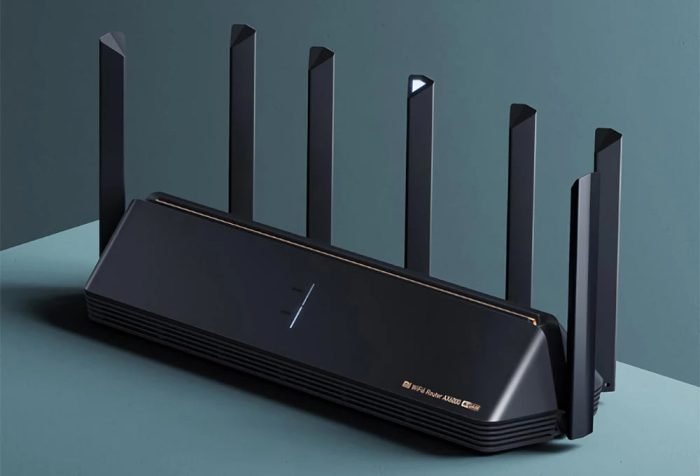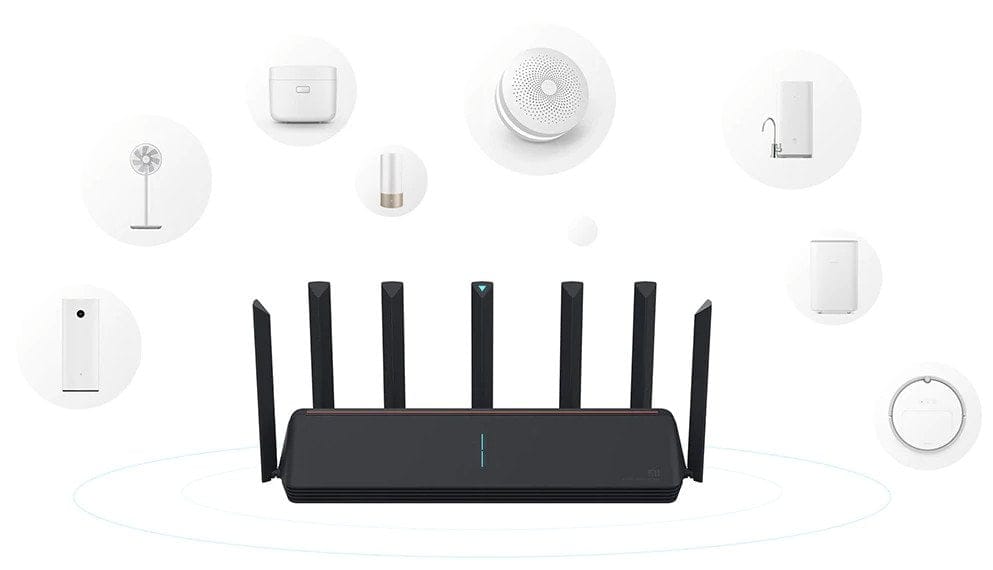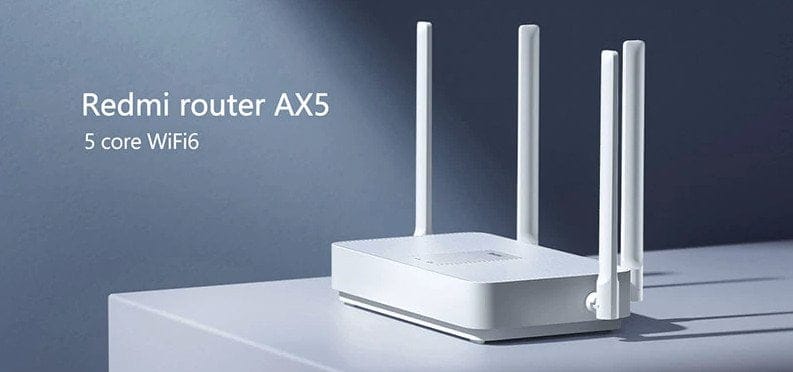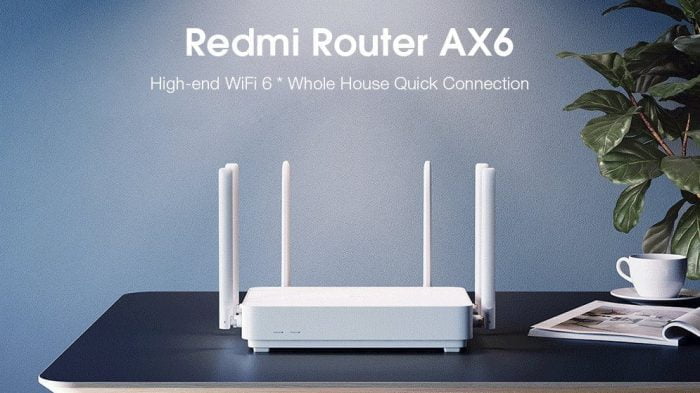Xiaomi WiFi 6 Router (2021)
XiaomiAX9000
The Xiaomi AX9000 was launched in early April 2021. As the design already reveals, the router was specially designed for gamers.
The Qualcomm IPQ9000 WiFi 1125 chip, which is supported by 1000GB of RAM, enables WLAN transmission speeds of up to 8072 Mbit / s (6 MB / s), distributed over up to 1 clients. However, one should keep in mind that it is the theoretical total speed on all bands (tri-band). A total of 12 antennas distribute the signal evenly and over a wide area.

Qualcomm's 4K-QAM is supported as well as MU-MIMO + OFDMA, Mesh and 2,5 Gbit / s Ethernet on 3 ports. With the help of the existing USB3.0 connection, the OpenWRT (MiWiFi) based AX9000 router can also be used as an external data storage device.
XiaomiAX6000
At the beginning of January 2021, Xiaomi presented the Xiaomi AX6000 router. As a WiFi 6 enhanced router, the AX6000 promises (theoretical) transfer rates of up to 6.000 Mbit / s (750 MB / s). With 4096QAM (4K QAM), the router delivers 12 instead of the previous 10 bits per symbol, which results in a 20 percent higher data rate. Even speeds of up to 2,5 Gbit / s are possible via the Ethernet connection.

The core of the router is the Qualcomm IPQ5018, a chip specially designed for WiFi 6 routers, which is able to supply more than 248 devices with WiFi at the same time. The main memory is 512MB. The current WPA3-SAE encryption makes the Xiaomi AX6000 even more secure than models with WPA2 certification. This router also uses the OpenWRT-based MiWiFi for the operating system.
XiaomiAX3600
The first WiFi 6 router from Xiaomi is also the most powerful model. It is the Xiaomi AX3600 router , which we reported about a few months ago. The router is currently only available as an import from China. At the end of March, Xiaomi also announced the global market launch. It is not yet known when it will happen. The RRP should then be 119,99 euros.

The AX3600 router is the top model in the new router series. Xiaomi has given the router considerable hardware, which is divided into a Qualcomm IPQ8071A CPU (4 Cortex-A57, 1 GHz clock rate), a dual-core NPU chip and 512MB of memory. As the name suggests, it is a router that supports all current WiFi protocols, including IEEE 802.11ax. Theoretically, 6 GHz WLAN would also be possible with this, but this is currently not activated. The operating system is MiWiFi, which is based on OpenWRT. Resourceful developers are already working on an alternative firmware, which makes the router even more interesting.

A total of 7 external antennas, which radiate the signal omnidirectionally over long distances, ensure excellent transmission and reception performance. One of the antennas is a special AIoT antenna that is purely responsible for integrating and controlling network devices. Other special features include OFDMA (Orthogonal Frequency Division Multiple Access), MU-MIMO (4x4), BSS Coloring and support for the new WPA3 encryption protocol. Friends of wired network transmission can look forward to a Gigabit WAN port and three Gigabit LAN ports. Auto MDI-X identifies the transmit or receive line of the connected cable.
XiaomiAX1800

The Xiaomi AX1800 is another WiFi 6 router that is somewhat weaker than the top model. The differences lie not only in the design, but also in the installed hardware. The core is a Qualcomm IPQ6000 (4 Cortex-A57, 1.2 GHz clock speed) with dual-core NPU chip and 256MB memory. At first glance, the CPU is slightly faster than that of the AX3600, but the differences lie in the details. The new IEEE 802.11ax WiFi protocol is supported. OFDMA is also present. MU-MIMO too, but only in a 2x2 version. External antennas are missing. Instead, there are 2 internal dual-frequency antennas inside the router. There is no special AIoT antenna.

Features like BBS coloring, WPA3, band merge and beamforming are available. The operating system is also MiWiFi based on OpenWRT. From the end of June 2020, the router will also receive a major software update that will make the router mesh compatible. The connections are identical to the top model with one Gigabit WAN port and three Gigabit LAN ports.
Xiaomi Redmi AX5

Another router in the lower price segment is the Redmi AX5 router. Redmi is Xiaomi's "young brand" that promises quality at the best price. The Redmi Ax5 comes in a simple white housing and is equipped with 4 external antennas that spread the signal omnidirectionally

The hardware, software and functionality are almost identical to the somewhat more expensive Xiaomi AX1800 router. The Qualcomm IPQ6000 chip is also installed here, although it is only supported by a single-core NPU (1.5 GHz clock rate). The memory has a size of 256MB. The router is advertised with an integrated mesh function.
Xiaomi Redmi AX6

In September 2020 Xiaomi released another Redmi router. The Redmi AX6 is largely comparable to the Xiaomi AX3600 router. The hardware is a Qualcomm IPQ8071A processor with a dual-core NPU and 512MB memory. The router supports the new WiFi 6 standard and achieves (theoretical) speeds of up to 2976 Mbit / s. Beamforming, BSS coloring, dual frequency, WPA3 and other functions are extensively supported.

Six omnidirectional antennas spread the WLAN signal over a large area. IoT devices can be easily integrated into the network with Xiaomi Easy Connect. Products from the Xiaomi ecosystem in particular benefit from this function.
Conclusion
The new WiFi 6 WLAN standard is only slowly picking up speed. Only a few routers with IEEE 802.11ax protocol support have made it onto the market so far. Entry-level models from relevant brands are available from around 80 euros, but these routers cannot attract with convincing functions. The situation is different with the less well-known Xiaomi routers. Starting prices of less than 50 euros make the WiFi 6 router series particularly attractive, which is why it is also worth importing.
The only obstacle is the cut to the Chinese market. So if you decide to import, you also opt for a MiWiFi user interface in Chinese. However, as you know from other Xiaomi import routers, the user interface can be easily translated with the Google translator. Provided there is an internet connection.
Alternatively, one can hope for a global launch of the router series. After all, Xiaomi has already announced this. The routers should come to Europe in the summer. The prices are then of course a little higher.










